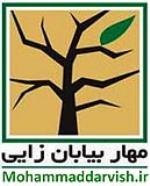دستاوردها و تجربیات ایران در مهار بیابان زایی (برگردان انگلیسی-7)
Important lessons and feedbacks:
One of the most applicable achievements of the research sector which is being implemented now since 2 decades ago is called “Abkhandary” or “water table management”, the positive feedbacks of which can be observed in different desert environments of the country. Abkhandary is an appropriate indigenous and low cost technique that can change the disadvantages of destroying floods into a great blessing in at least 14 million hectares of lands of the country (Kowsar, 1995, 2001); a technique that is considered an example of discovery and taking advantage of the historical potentials (a means for realization of development) and has been approved scientifically and administratively by the Food and Agriculture Organization of the United nations (FAO) as a solution to survive world’s 800 million hungry human beings from malnutrition (Malakouti, 2002); by absorbing only 7000 billion Rials credit and controlling 4 billion cubic meters of runoff water, Abkhandary can minimize the damages caused by floods and droughts.
Another feedback of “Abkhandary” is that it can help to revolutionize the view points of the administrative decision makers in the field of natural resources; Due to this technique, today no one thinks of the 35 million hectares of sand dunes and desert sumps as desertification signs that should be eliminated. During the current decade, the desertification control activities are not delimited to 5 million hectares of deserts or even 148 million hectares (89.7 percent area of the country) of dry lands. It has been proved that desertification can occur independently in every environment with habitation potentials, any distance from the sea, altitude from the high seas surface, latitude or annual precipitation.
 به «مهار بيابانزايي» خوش آمديد؛ تارنمايي كه از 12 فروردین 1384 کلید خورده است و تاکنون جوایز متعدد منطقهای، ملّی و جهانی بدست آورده؛ از جمله: در آبان 1385 و اردیبهشت ماه 1387، عنوان برترین وبلاگ محیط زیستی ایران را بدست آورد؛ در فروردین ماه سال 1389 به عنوان سومین وبلاگ محبوب محیط زیستی جهان در سال 2009 انتخاب شد؛ در دوم اردیبهشت 1392، وبگاه نخست محیط زیستی پایتخت در جشنواره مشکات برای سال 1391 شد و سرانجام در 17 اردیبهشت 1392، برنده عنوان برترین وبلاگ به انتخاب مردم در اجلاس جهانی رسانهها برای سال 2013 شد. محمّد درویش در این محیط مجازی ميكوشد در گام نخست جايگاه محيط زيست را در سبد اولويتهاي راهبردي كشور، به منزلگاهي درخور ارتقاء بخشد؛ و در گام بعدي ثابت كند كه بخش پهناوري از زيستبوم وطن، همان قلمرو برهنه و سوزان ماسههاي بادي و شورابهاي كويري و كلوتهاي سر به فلك كشيده و نبكاهاي استوار عرصههاي بياباني، ميتواند پايدارترين و غنيترين صندوق ذخيرهي ارزي ايرانيان باشد. به شرط آنكه بكوشيم با نفي «بيابانزدايي»، از بيابانيشدن زيستبومهاي تالابي، جنگلي و مرتعي خويش جلوگيري كنيم.
به «مهار بيابانزايي» خوش آمديد؛ تارنمايي كه از 12 فروردین 1384 کلید خورده است و تاکنون جوایز متعدد منطقهای، ملّی و جهانی بدست آورده؛ از جمله: در آبان 1385 و اردیبهشت ماه 1387، عنوان برترین وبلاگ محیط زیستی ایران را بدست آورد؛ در فروردین ماه سال 1389 به عنوان سومین وبلاگ محبوب محیط زیستی جهان در سال 2009 انتخاب شد؛ در دوم اردیبهشت 1392، وبگاه نخست محیط زیستی پایتخت در جشنواره مشکات برای سال 1391 شد و سرانجام در 17 اردیبهشت 1392، برنده عنوان برترین وبلاگ به انتخاب مردم در اجلاس جهانی رسانهها برای سال 2013 شد. محمّد درویش در این محیط مجازی ميكوشد در گام نخست جايگاه محيط زيست را در سبد اولويتهاي راهبردي كشور، به منزلگاهي درخور ارتقاء بخشد؛ و در گام بعدي ثابت كند كه بخش پهناوري از زيستبوم وطن، همان قلمرو برهنه و سوزان ماسههاي بادي و شورابهاي كويري و كلوتهاي سر به فلك كشيده و نبكاهاي استوار عرصههاي بياباني، ميتواند پايدارترين و غنيترين صندوق ذخيرهي ارزي ايرانيان باشد. به شرط آنكه بكوشيم با نفي «بيابانزدايي»، از بيابانيشدن زيستبومهاي تالابي، جنگلي و مرتعي خويش جلوگيري كنيم.